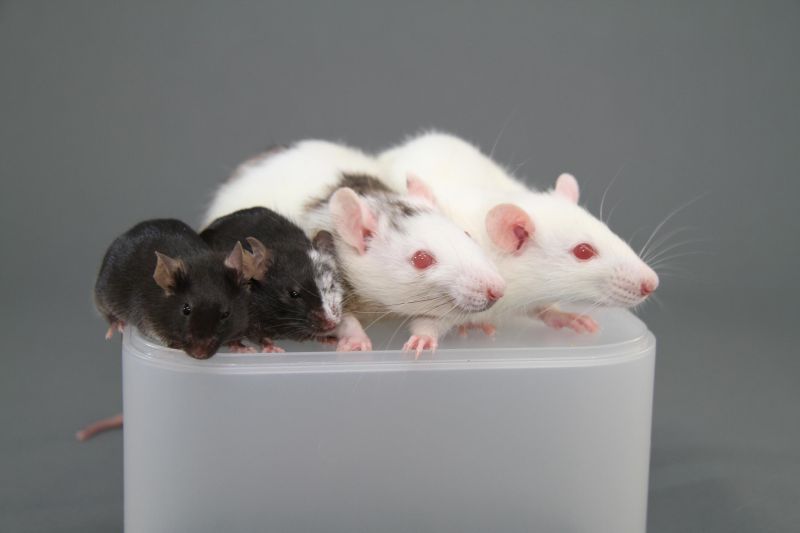A group of seven Stanford scientists spoke out last week against the National Institute of Health’s decision to suspend funding for a specific type of stem cell research. They argued that the moratorium will discourage work with tremendous potential to advance medicine.
Through a critical letter published last Thursday in Science and testimonies at a National Institute of Health (NIH) workshop held the following day, the Stanford researchers defended an experimental technique that implants animal embryos with human pluripotent stem cells (hPSCs) — “master” cells that are able to mature into any adult cell type.
This process results in the creation of a “chimera,” an animal containing cells from multiple species.
The scientists say the technique could lead to valuable and life-saving applications, from treating degenerative disease to growing human organs for transplant.
However, critics worry that human-animal chimeras created by this line of research could be ethically problematic. A notice from the NIH on Sept. 23 announced that in light of the area’s “rapid expansion,” the organization would indefinitely halt support for new projects involving human hPSCs and animal embryos in order to evaluate ethical and animal welfare concerns more thoroughly.
Law professor Hank Greely ’74 said that although NIH is the largest funder of biomedical research in the U.S., it’s not the only one.
“Historically the NIH has not been an enormous funder of stem cell research, in part because of the Bush Administration’s concern,” Greely said.
Even so, the NIH’s new policy will limit Stanford scientists’ options for supporting their work on human-animal chimeras. Vittorio Sebastiano, an assistant professor of obstetrics and gynecology, said he will have to find alternative funding for his work investigating early human development.
Professor of genetics Hiromitsu Nakauchi has hoped for many years to grow human organs in pigs — an ambitious idea that he admits some call “science fiction.” However, he also explained that recent progress in chimera research is bringing the idea closer to reality. Nakauchi’s 2010 paper laid the foundations for such a goal by demonstrating a successful animal-animal chimera between rats and mice.
Nakauchi is funded by the California Institute of Regenerative Medicine (CIRM) rather than the NIH, so his project can continue unhindered for now.
“But of course I could apply for the NIH grant [in the future], so eventually this will affect me,” Nakauchi said.
CIRM was established in California to distribute $3 billion in funding for stem cell research over a decade; unless additional state legislation is passed, its support will end in a few years — further narrowing scientists’ options.
Researchers’ concerns over the NIH’s decision go beyond the ability to fund their own current projects. Assistant professor of medicine Sean Wu ’92, the senior author of the letter to Science, said he fears the long-term impacts of the moratorium.
“This kind of restriction on funding will really dampen enthusiasm from young people who are thinking about what lab to work in, what technology to train in [and] how to develop their scientific career,” Wu said.
“The NIH policy is, at the moment, not necessarily preventing work that is currently ongoing, as much as preemptively preventing people from pursuing a line of work where the research is heading,” he added.
David Magnus Ph.D. ’93, a professor of medicine and the director of Stanford’s Center for Biomedical Ethics, foresees potential repercussions for other areas of controversial scientific inquiry.
“I’m worried not only because it means valuable research won’t take place, I’m very worried about it as a precedent,” Magnus said. “The idea that… let’s just fund research that nobody ever objects to. That’s a good way to have really bad science and not a lot of it.”
Magnus spoke of the “yuck factor” that can accompany stem cell research, especially the human-animal embryo work that the NIH is currently concerned about. For Magnus and his fellow scientists, the NIH’s suspension of funding is based on largely unfounded fears.
“Many oversight mechanisms exist for research involving human subjects and cells,” the scientists’ letter in Science reads.
Guidelines set out by the National Academy of Sciences evaluate chimeric research projects on an individual basis for potentially harmful implications, such as the creation of animals with human-like brains or human eggs and sperm — outcomes that are unlikely in most chimeric experiments because the species being mixed are so different.
“If you were to, say, put lots of human brain stem cells into a three-week-old gorilla embryo, that would be worrisome,” Greely said. “But that’s the kind of experiment that would be picked up under those guidelines.”
On Nov. 6, Greely and Nakauchi traveled to NIH headquarters in Maryland to present at a workshop on the issue of human-animal chimera research, along with approximately 20 scientists and ethicists from around the world. Greely and Nakauchi said that speakers unanimously opposed the halt on funding.
“I think we all said this research should go forward; you should lift the moratorium; here are proven effective methods to alleviate your concerns,” Greely said.
Will the NIH take heed? Right now, Greely and others say it is hard to tell.
“[The NIH] was definitely in listening mode,” Greely said. “They weren’t in talking mode. They wanted to hear what we had to say.”
Wu said that for now, he and the other the letter authors will focus on publicizing their cause.
“If we don’t see anything happening in a month or two, we’ll probably have to go on a bigger campaign and try to get even more people involved,” Wu said.
Contact Hannah Knowles at hknowles ‘at’ stanford.edu.
